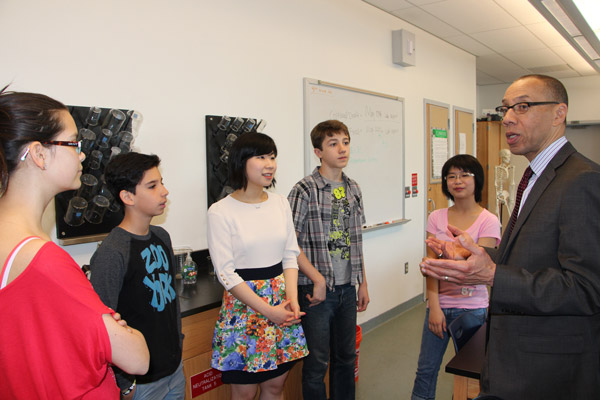
Schools Chancellor Dennis Walcott spoke with I.S. 276 students Maya Gardner, left, Julian Apprendi, their teacher Youngjee Kim, and fellow classmates Max Sano and Ashley Ip. The U.S. Army awarded the students $500 bonds for their science work.
BY KAITLYN MEADE | Schools Chancellor Dennis Walcott came to Battery Park City’s P.S./I.S. 276 to congratulate a team of seventh-graders whose experiment won the Lower Manhattan school second place in the state in a science and technology competition.
On May 7, Max Sano, Ashley Ip, Maya Gardner and Julian Apprendi shook hands and posed for pictures with the chancellor in the science room of I.S. 276.
The team, named the “Bateria Assassins” — which became an inside joke after they submitted their title without the requisite “c” in “bacteria” — are four seventh grade students whose dedication led them to stay in the classroom after school or work via “Gchat,” Google Docs and text messaging from home.
“We all learned you really have to cooperate and make sure everyone is ready to do it, or you won’t be able to,” said Max Sano.
“This is extra work for them — they had to manage their time,” said their teacher, Youngjee Kim. Even though the experiment itself did not take long, she said the students were involved every step of the way from planning out their experiment, addressing all the questions, organizing and presenting the resulting data and putting it online to be judged.
Two teams of Kim’s seventh grade students from the Battery Park City School entered the E-Cybermission competition, which is a free, web-based Science, Technology, Engineering and Mathematics (STEM) program sponsored by the U.S. Army. The teams compete to identify and solve community problems.
“Bateria Assassins” decided to research how keeping an area bacteria free would help the community by looking at the effects of different of concentrations of ethyl alcohol on e-coli bacteria. They studied the effectiveness of different hand sanitizing gels and learned that “ethyl alcohol concentration does matter, but you don’t need a whole lot to kill those nasty germs.” In fact, 65 percent was found to be the optimum level.
“See, you have influenced my purchasing, because I do look at labels,” said Walcott to the team of students when they explained their findings.
The students said that winning, and the attendant $500 U.S. Savings Bond, were just icing on top of the experience itself.
“I’ve always loved science and I want to specialize in science,” said Maya Gardner, who was initially interested in field scientists like Jane Goodall, but said the competition showed her different opportunities in the area of science. “This has kind of opened up a new door, like, ‘Hey, this isn’t the only thing I can do.’”
“In elementary school, I didn’t like the way we did science. We’d just study for tests and then forget everything…. We do hands-on experience now. We do labs and watch movies, we still use the text books, but we discuss it afterwards,” said Ashley Ip.
“This is what’s happening as the result of a great science teacher,” Walcott said. He also noted principal Terri Ruyter’s dedication to science education.
Next year, the four students plan on doing a more advanced project in field science — in the same team, of course.

















